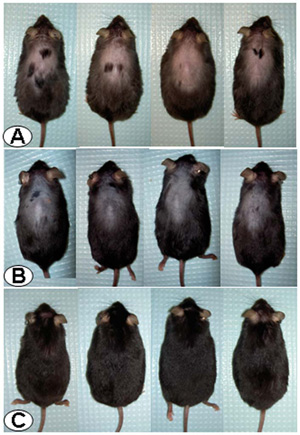The international study team, led by cell biologist Valter Longo of the University of Southern California and Ecuadorian endocrinologist Jaime Guevara-Aguirre, followed a remote community on the slopes of the Andes mountains.
The community includes many members with Laron syndrome, a deficiency in a gene that prevents the body from using growth hormone. The study team followed about 100 such individuals and 1,600 relatives of normal stature.
Over 22 years, the team documented no cases of diabetes and one non-lethal case of cancer in Laron's subjects.
Among relatives living in the same towns during the same time period, 5 percent were diagnosed with diabetes and 17 percent with cancer.
Because other environmental and genetic risk factors are assumed to be the same for both groups, Longo and his team concluded that -- at least for adults past their growing years -- growth hormone activity has many downsides.
"The growth hormone receptor-deficient people don't get two of the major diseases of aging. They also have a very low incidence of stroke, but the number of deaths from stroke is too small to determine whether it's significant," Longo said.
Overall lifespan for both groups was about the same, with the abnormally short subjects dying more often from substance abuse and accidents. The study did not include psychological assessments that could have helped explain the difference.
"Although all the growth hormone deficient subjects we met appear to be relatively happy and normal and are known to have normal cognitive function, there are a lot of strange causes of death, including many that are alcohol-related," Longo said.
Longo noted that any treatment for preventive reduction of growth hormone would have to show fewer and milder side effects than drugs used against a confirmed disease.
But he added that any preventive treatment would target adults with high growth hormone activity in order to bring it down to average, and not to the extremely low and potentially riskier state observed in Laron's subjects.
If high growth factor levels "become a risk factor for cancer as cholesterol is a risk factor for cardiovascular diseases," drugs that reduce the growth factor could become the new statins, Longo said.
Such drugs would be used at first only for families with a very high incidence of cancer or diabetes.
And because growth hormone activity decreases naturally with age, any preventive treatment would be appropriate only until the effects of advanced age took over, Longo explained.
Animal studies provide evidence for the health benefits of blocking growth hormone. Groups led by John Kopchick of Ohio University and Andrzej Bartke of Southern Illinois University achieved a record 40 percent lifespan extension with growth factor deficient mice in studies published in 2000 and 1996, respectively.
Later, the researchers linked growth factor deficiency to reduced tumor risk.
The Food and Drug Administration has already approved drugs that block growth hormone activity in humans. These are used to treat acromegaly, a condition related to gigantism.
Because studies have shown that growth hormone deficiency protects mouse and human cells against some chemical damage, Longo said his team would initially seek approval for a clinical trial to test such drugs for the protection of patients undergoing chemotherapy.
Growth hormone-blocking drugs such as pegvisomant appear to be well tolerated, Longo said. But even if chronic growth hormone blocking should come with a minor side effect, Longo predicted that societies and governments would make the trade in exchange for less chronic disease.
He called it the "square survival curve," where most of one's life is lived without major illness.
"It's the dream of every administration, anywhere in the world. You live a long healthy life, and then you drop dead," Longo said.
Exactly how growth hormone deficiency might protect a person is not fully understood.
In test tube studies, Longo's team found that serum from Laron's subjects had a double protective effect: it protected DNA against oxidative damage and mutations but it promoted the suicide of cells that became highly damaged.
Laron's subjects tend to have very low insulin levels and low insulin resistance, which may explain the absence of diabetes.
In joint experiments with a group led by Rafael de Cabo at the National Institute on Aging, human cells exposed to the Laron's serum also showed surprising changes in the activity of genes linked to life extension in yeast and other model organisms. Although Longo and colleagues had identified such genes 15 years ago, they had not been shown to be important for disease prevention in humans.
Artificial hormone blocking is not the only way to reduce these hormones in humans.
A natural method appears to achieve the same effect: restriction of calories or of specific components of the diet such as proteins.
Several studies are underway to assess the effect of dietary restriction in humans and other primates. The results are not yet known, but a recent study by Longo's group showed that fasting induces rapid changes in growth factors similar to those caused by the Laron mutation.
However, because fasting or restriction in particular nutrients for long periods can lead to dangerous conditions including anorexia, reduced blood pressure and immunosuppression -- and because individuals with rare genetic mutations can suffer life-threatening effects from even short periods of fasting -- Longo emphasized that additional studies are needed and that any changes in diet must be approved and monitored by a physician.
The study in Science Translational Medicine began as an attempt by Longo to test evidence from animal studies that longevity mutations prevent progressive DNA damage and/or cancer.
Co-author Guevara-Aguirre wanted to understand the reasons for the stunted growth of children in the remote community, centered in the Loja province of southern Ecuador.
Initially, Longo said, the children "were more looked at in search of problems than solutions."
But as the study wore on, Guevara-Aguirre began to notice that the adults in the community were not dying of the usual chronic diseases.
That was the clue Longo had been seeking. After hearing of the Ecuador study, he invited Guevara-Aguirre to present at a symposium on aging and cancer in 2006 at USC's Leonard Davis School of Gerontology, where Longo is associate professor.
Together, they obtained funding from the Center of Excellence in Genomic Science in the USC College of Letters, Arts and Sciences, which sponsored part of the initial field research in Ecuador, and from the National Institute on Aging, which sponsored the cellular studies.
Longo and Guevara-Aguirre's collaborators were co-lead author Priya Balasubramaniam, postdoctoral researcher in Longo's laboratory in the USC Leonard Davis School of Gerontology; Sue Ingles, associate professor in the Keck School of Medicine of USC; Min Wei, research assistant professor, Federica Madia, research associate, and Chia-Wei Cheng, graduate student, all in Longo's lab; Marco Guevara-Aguirre and Jannette Saavedra of the Institute of Endocrinology, Metabolism and Reproduction, in Quito, Ecuador; David Hwang and Pinchas Cohen of the David Geffen School of Medicine at UCLA; Rafael de Cabo of the National Institute on Aging; and Alejandro Martin-Montalvo of the National Institute on Aging and the Centre for Biomedical Research on Rare Diseases in Sevilla, Spain.
Balasubramaniam and Marco Guevara-Aguirre were responsible for major parts of the study in the laboratory and in the field, respectively.






